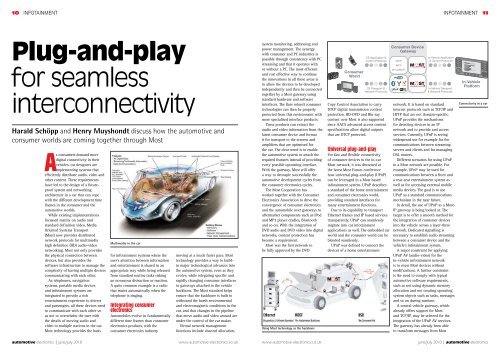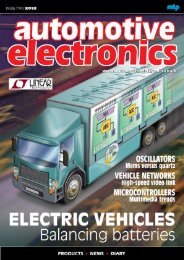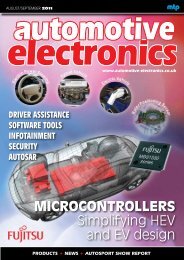ting Now - Automotive Electronics
ting Now - Automotive Electronics
ting Now - Automotive Electronics
- No tags were found...
You also want an ePaper? Increase the reach of your titles
YUMPU automatically turns print PDFs into web optimized ePapers that Google loves.
10 INFOTAINMENTINFOTAINMENT 11Plug-and-playfor seamlessinterconnectivityHarald Schöpp and Henry Muyshondt discuss how the automotive andconsumer worlds are coming together through MostAs consumers demand moredigital connectivity in theirvehicles, car designers areimplemen<strong>ting</strong> systems thatefficiently distribute audio, video andother content. These requirementshave led to the design of a futureproofsystem and networkingarchitecture in a car that can copewith the different development timeframes in the consumer and theautomotive worlds.While exis<strong>ting</strong> implementationsfocussed mainly on audio andstandard definition video, MediaOriented Systems Transport(Most) now provides distributednetwork protocols for multimediahigh definition (HD) audio-videonetworking. Most not only providesthe physical connection betweendevices, but also provides thesoftware infrastructure to manage thecomplexity of having multiple devicescommunica<strong>ting</strong> with each other.As telephones, navigationsystems, portable media devicesand infotainment systems areintegrated to provide a richentertainment experience to driversand passengers, all these devices needto communicate with each other soas not to overwhelm the user withthe details of moving audio andvideo to multiple stations in the car.Most technology provides the basisMultimedia in the carfor infotainment systems where theuser’s attention between informationand entertainment is shared in anappropriate way while being releasedfrom standard routine tasks riskingan erroneous distraction or reaction.A quite common example is a radiothat mutes automatically when thetelephone is ringing.Integra<strong>ting</strong> consumerelectronicsAutomobiles evolve in fundamentallydifferent time frames than consumerelectronics products, with theconsumer electronics industrymoving at a much faster pace. Mosttechnology provides a way to buildinmajor technological advances intothe automotive system, even as theyevolve, while relega<strong>ting</strong> specific andrapidly changing consumer interfacesto gateways attached to the vehiclebackbone. The Most standard helpsensure that the backbone is built towithstand the harsh environmentaland electromagnetic conditions in thecar, and that changes in the pipelinethat move audio and video around areunder the control of the car maker.Virtual network managementfunctions include channel allocation,system monitoring, addressing andpower management. The synergywith consumer and PC industries ispossible through consistency with PCstreaming and that it operates withor without a PC. The most efficientand cost effective way to continuethe innovations in all these areas isto allow the devices to be developedindependently and then be connectedtogether by a Most gateway usingstandard hardware and softwareinterfaces. The (less robust) consumertechnologies can then be properlyprotected from this environment withmore specialised interface products.These products can extract theaudio and video information from thelatest consumer device and formatit for transport to the screens andamplifiers that are optimised forthe car. The clear trend is to enablethe automotive system to attach therequired features instead of providingevery possible upcoming interface.With the gateway, Most will offera way to decouple successfully theautomotive development cycles fromthe consumer electronics cycles.The Most Cooperation hasworked together with the Consumer<strong>Electronics</strong> Association to drive theconvergence of consumer electronicsand the automobile over gateways toaftermarket components such as IPodand MP3 player cradles, Bluetoothand so on. With the integration ofDVD audio and DVD video into digitalnetworks, content protection hasbecome a requirement.Most was the first network tobe fully approved by the DVDUsing Most technology as the backboneCopy Control Association to carryDTCP digital transmission contentprotection. HD-DVD and Blu-raycontent over Most is also supportedsince AACS advanced access contentspecifications allow digital outputsthat are DTCP protected.Universal plug-and-playFor fast and flexible connectivityof consumer devices to the in-carMost network, it was discussed atthe latest Most Forum conferencehow universal plug-and-play (UPnP)can be leveraged in a Most basedinfotainment system. UPnP describesa standard of the home entertainmentand consumer electronics world,providing standard interfaces formany entertainment functions.Due to its capability to transportEthernet frames and IP based servicestransparently, UPnP can seamlesslymigrate into car infotainmentapplications as well. The embedded carworld and the consumer world can beblended seamlessly.UPnP was defined to connect thedevices of a home entertainmentnetwork. It is based on standardinternet protocols such as TCP/IP andHTTP that are not domain-specific.UPnP provides the mechanismsfor detec<strong>ting</strong> devices in an IPnetwork and to provide and accessservices. Currently, UPnP is seeingwidespread use for example for thecommunications between streamingservers and clients and for managingDSL routers.Different scenarios for using UPnPin a Most network are possible. Forexample, UPnP may be used forcommunications between a front anda rear-seat entertainment system aswell as for accessing external mobilemedia devices. The goal is to useUPnP as a standard communicationsmechanism in the near future.In detail, the use of UPnP as a Most-IP gateway is being looked at. Thetarget is to offer a smooth method forthe integration of consumer devicesinto the vehicle across a layer-threenetwork. Dedicated signalling isnecessary to establish audio streamingbetween a consumer device and thevehicle’s infotainment system.A major constraint for applyingUPnP AV (audio-video) for thein-vehicle infotainment networkis to reuse Most devices withoutmodifications. A further constraintis the need to comply with typicalautomotive software requirements,such as not using dynamic memoryallocation and not crea<strong>ting</strong> opera<strong>ting</strong>system objects such as tasks, messagesand so on during runtime.A central vehicle gateway, whichalready offers support for Mostand TCP/IP, may be selected for theintegration of the UPnP AV services.The gateway has already been ableto transform messages from MostConnectivity in a carautomotive electronics | june/july 2010www.automotive-electronics.co.ukwww.automotive-electronics.co.uk june/july 2010 | automotive electronics




